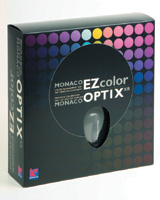Monaco's EZcolor/OPTIXXR
Take Control Of Color Management
For both Windows and Mac, Monaco Systems has greatly simplified the once daunting process of building color profiles for your monitors, scanners, digital cameras, and printers to deliver accurate and consistent color across devices and paper and ink types. These profiles characterize how each device represents color. Then, image-editing and printing software such as Photoshop Versions 5 through CS and your printer drivers can apply this information to maintain consistent, accurate color from one device to another. |
||||||||||||
Calibrate And Profile
Your Monitor |
||||||||||||
Why do you need color management? Because each device in your workflow reproduces color quite differently. Scanners, monitors, and printers use different color spaces, reproduce different gamuts of color, and have different dynamic ranges. Especially if you are using papers or inks other than those from your printer manufacturer, profiling them for a color managed workflow can make a tremendous difference. If you're printing black and white images with all your inks in order to achieve the smoothest tonal gradations, profiling can help make the prints neutral, without an unwanted color cast. The Color Management
Team Profile To Taste Real-World Results |
||||||||||||
In the Monaco profiled version,
#9, the shadow is much more accurate, and there is no yellow tinge in
the mid-tone areas of the hair. Further, the saturation of pink in the
flesh tones is not exaggerated, and is much closer to the original. Finally,
the wall color is more neutral, and the overall contrast of the image
is lower, showing more detail in the shadow areas of the hair. In additional
black and white tests, not shown, when printing in RGB to use all inks,
the Monaco profiles created neutral blacks, while prints made with the
manufacturer's profiles had yellow, brown, and green casts. |











































